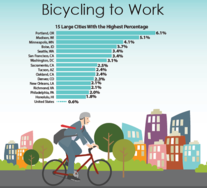What's Inside this Issue: Welcome to the Philadelphia Region Data Dissemination Newsletter!We hope that the new Data Dissemination Newsletter from the Census Bureau's Philadelphia Region will help to make you aware of new and ongoing data releases, and will encourage you to use the various tools available on census.gov. Whether you are interested in national-level data, or you have a specific Census tract in mind, we likely have the data you need. Don't forget, we can also provide trainings and presentations. Please let us know how we can assist you by reaching out to your state's contact ~ we look forward to hearing from you! PA, DE - Whittona Burrell whittona.r.burrell@census.gov; Noemi Mendez Eliasen noemi.mendez@census.gov MD, DC - Nesreen Khashan nesreen.khashan@census.gov VA - Ally Burleson-Gibson allyson.r.burleson.gibson@census.gov TN, KY - Erran Persley erran.f.persley@census.gov OH, WV - Tim Sarko timothy.a.sarko@census.gov Biking to Work Increases 60 Percent Over Last Decade
Many U.S. cities are seeing an increase in bicycle commuters, according to a U.S. Census Bureau report released May 8. "Modes Less Traveled — Bicycling and Walking to Work in the United States: 2008-2012," highlights the trends and socio-economic and geographic differences between motorized and nonmotorized commutes. This report — the Census Bureau's first focusing only on biking and walking to work — is one of many that examines specific aspects of commuting, including workplace location, working from home, long commutes and specific travel modes. Biking to Work HighlightsThe West had the highest rate of biking to work at 1.1 percent, and the South had the lowest rate at 0.3 percent. Men were more likely to bike to work than women were. The rate of bicycle commuting for men was more than double that of women, 0.8 percent compared with 0.3 percent. Those with a graduate or professional degree or higher and those with less than a high school degree had the highest rates of biking to work, at 0.9 and 0.7 percent, respectively. Walking to Work Highlights The Northeast showed the highest rate of walking to work at 4.7 percent of workers. The South had the lowest rate at 1.8 percent. Workers living in core cities walked to work at a rate of 4.3 percent, compared with 2.4 percent for workers in suburbs. Men walked to work at a rate of 2.9 percent compared with 2.8 percent for women. Those with less than a high school degree had the highest rate of walking to work at 3.7 percent, followed by those with graduate or professional degrees at 2.7 percent. |
Mining, Quarrying, Oil and Gas Extraction Booming, According to First Results from the Census Bureau's 2012 Economic CensusThe mining, quarrying, and oil and gas extraction sector of the economy showed tremendous growth from 2007 to 2012 as the number of establishments rose by 26.4 percent, according to the 2012 Economic Census Advance Report released by the U.S. Census Bureau. Revenue for mining, quarrying, and oil and gas extraction grew 34.2 percent to $555.2 billion from 2007 to 2012. It also was among the fastest growers in employment as the number of employees rose 23.3 percent to 903,641. The report is the first in a series of industry and geographic area data products. It contains statistics at the national level only for broad industry sectors of the economy, such as energy. New to the 2012 Economic Census, and available later this year, will be information on emerging industries, including solar, wind, geothermal and biomass electric power generation. Among the findings in this report: - The retail trade sector had the most businesses in 2012 (nearly 1.1 million), while the utilities sector had the least (17,804).
- The utilities sector achieved the highest average revenue per establishment in 2012 of more than $29 million per establishment.
- The health care and social assistance sector continued to have the most employees with more than 18 million in 2012, an increase of more than 10 percent or 1.8 million people from 2007. This is the highest numerical increase of employees in any sector published in the advance report.
Economic census statistics will be released over a two-year period, through June 2016. Statistics at the local level, including information for more than 5,000 communities not available from previous economic censuses, will be available starting in February 2015. Reference information about the economic census, including a data release schedule, is available on the 2012 Economic Census home page. Users can sign up to receive alerts when particular industry or geographic reports are released via the soon to be available economic census GovDelivery service at business.census.gov. Adopted Children More Likely to Live in Highly Educated Home Seventeen percent of adopted children under age 18 lived with a householder with a graduate or professional degree, according to American Community Survey statistics available in a new report released by the U.S. Census Bureau. In comparison, 12 percent of biological children and 6 percent of stepchildren lived with a householder with at least one of these degrees. Seventeen percent of adopted children under age 18 lived with a householder with a graduate or professional degree, according to American Community Survey statistics available in a new report released by the U.S. Census Bureau. In comparison, 12 percent of biological children and 6 percent of stepchildren lived with a householder with at least one of these degrees.
The report, Adopted Children and Stepchildren: 2010, examines the characteristics of adopted children and stepchildren and the parents they live with using multiyear data from the American Community Survey (2009-2011) in addition to the 2010 Census and the 2012 Current Population Survey. In 2010, of the 64.8 million children of the householder under age 18, 93 percent were the biological children of the householder, 4 percent were stepchildren and 2 percent were adopted children. |
| 

